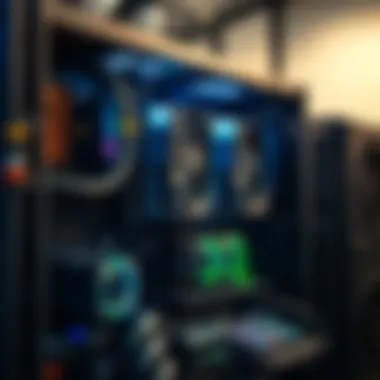Understanding Mining Rig Systems in Cryptocurrency


Intro
The realm of cryptocurrency is not just a playground for traders and developers, but it is also deeply rooted in the technical foundation that drives its decentralized nature. A cornerstone of this ecosystem is the mining rig systems, which serve as the engines powering various blockchains. Understanding these systems opens the door to grasping how cryptocurrency operates in its entirety—from transaction validation to the creation of new coins.
In the following sections, we'll break down the architecture of these mining rigs, the components essential for their functioning, and the economic implications of mining in today's market.
Crypto Concepts Explained
Key Terminology and Definitions
Diving into mining rig systems requires familiarity with some cornerstone terms that define this space. Here are some key concepts that are fundamental to understanding:
- Hash Rate: This is the measure of computational power the mining rig uses to solve complex mathematical problems. It's like the speedometer for mining — the higher the hash rate, the more coins can be mined successfully.
- Proof of Work: A consensus mechanism used by many cryptocurrencies, it requires miners to perform calculations that validate transactions on the network. It's the "work" that miners do, ensuring the integrity of the blockchain.
- Block Reward: This is the incentive given to miners for successfully validating a new block on the blockchain. It usually consists of newly created coins plus transaction fees.
- Mining Pool: A collective where multiple miners join forces to enhance their chances of successfully mining coins. This increases their hash power and, consequently, their collective rewards.
Grasping these definitions lays a solid foundation for a deeper dive into the technicalities of mining rigs.
Practical Applications of Blockchain Technology
Mining rigs do not exist in a vacuum. They play a critical role in various applications of blockchain technology. When we think about blockchain, we often think of cryptocurrency, but its applications are manifold:
- Supply Chain Management: By providing transparent and immutable records, blockchain enhances supply chain logistics, allowing for better tracking and compliance.
- Digital Identity Verification: Blockchain aids in secure identity validation processes, removing the need for intermediaries.
- Smart Contracts: These self-executing contracts with predefined terms eliminate the need for third-party involvement in transactions, streamlining various processes across sectors.
Understanding these applications gives meaning to why mining rig systems are pivotal—they are not just about numbers and power, but the infrastructure of a new digital paradigm.
Investment Strategies
Analyzing Market Trends and Indicators
Investing in mining rig systems goes beyond just purchasing hardware. It includes the art of interpreting market trends and indicators. Significant indicators include:
- Difficulty Adjustment: The network's response to the total hashing power. This influences not only the time it takes to mine a block but also the potential profitability of mining.
- Energy Costs: As electricity is a primary operational cost, monitoring energy prices in your area can dramatically affect the decision to mine.
- Market Sentiment: Understanding how the market perceives various cryptocurrencies can shape investment and operational decisions. Engaging in forums such as Reddit or reviewing news on Facebook can provide insights into trending sentiments.
Risk Management Techniques
Every investment comes with its fair share of risks. Implementing sound risk management techniques can be the difference between profit and loss. Here are a few strategies:
- Diversification: Don't put all your eggs in one basket. Spread your investments across different cryptocurrencies to mitigate risks.
- Hardware Selection: Invest in reliable and proven mining rigs to avoid the pitfalls of cheaper, unreliable equipment.
- Monitoring Performance: Regularly track your mining rig's performance metrics and be ready to adapt your strategies or invest in the latest technology if needed.
By understanding these investment strategies, miners and investors alike can navigate the waters of cryptocurrency with more confidence and precision.
"In the world of cryptocurrency, knowledge is as crucial as the technology itself. The more you know, the better your position on the field."
In the following sections, we will expand upon the operational dynamics and maintenance of mining rigs, preparing you with the knowledge to make informed decisions within this technical domain.
Foreword to Mining Rig Systems
Mining rig systems are at the heart of the cryptocurrency ecosystem. As new currencies rise and the demand for transactions creates waves in the digital seas, the concept of mining takes on vital importance. Unlike traditional finance, where institutions mainly hold sway, cryptocurrencies operate on a decentralized model that hinges significantly on the role of miners. They validate transactions, secure the network, and, in turn, are rewarded with cryptocurrency, establishing a structure that is both innovative and complex.
The Importance of Mining in Cryptocurrency
Mining is more than just a technical process; it's the backbone of cryptocurrency operations. Every transaction requires verification, and miners ensure the integrity of this process. Without mining, the entire system would be susceptible to fraud and manipulation. This is where mining rig systems come into play. They are collections of hardware designed specifically to tackle the cryptographic puzzles necessary to validate transactions on the blockchain.
Mining keeps the network alive, and its significance grows as cryptocurrencies gain traction in various sectors. The decentralized nature of these currencies means that power is distributed among users rather than held by central authorities. Consequently, each miner contributes towards the overall security of the network.
"Without miners, the leading cryptocurrencies would crumble under their weight. They are the unsung heroes of the crypto space."
In addition to transaction validation, mining plays a crucial role in the issuance of new coins. It serves a dual purpose: first, as a method to secure the network and, second, as a way to introduce new coins into circulation while regulating inflation. This is a balancing act—keeping the system secure while ensuring that new units are not produced at an overwhelming pace.
Overview of Mining Rig Systems
Mining rig systems can vary widely in terms of hardware and design, but they share common goals: maximizing efficiency and profitability. At their core, mining rigs consist of powerful components working together to solve complex mathematical problems.
There are several key aspects to understand about mining rigs:
- Types of Rigs: Rigs vary from Application-Specific Integrated Circuits (ASICs), which are designed for specific algorithms to Graphics Processing Units (GPUs) that can handle diverse tasks.
- Performance Metrics: Hash rate, power consumption, and treatment of heat are all critical metrics in evaluating the efficacy of a mining rig.
- Setup and Maintenance: Setting a rig requires careful consideration of components and configurations. Once set up, continuous maintenance is essential to ensure consistent performance and longevity.
- Economic Implications: The costs of operation including electricity and hardware can affect overall profitability, along with market trends that dictate mining rewards.
Understanding these elements is pivotal for anyone looking to navigate this technical landscape effectively. As cryptocurrencies continue to expand, grasping the complexities of mining rig systems will empower investors, analysts, developers, and enthusiasts to make informed decisions in an ever-evolving environment.
Types of Mining Rigs
Mining rigs play a crucial role in the cryptocurrency ecosystem, as they are the backbone of processing transactions and securing the network. Understanding the types of mining rigs can help investors, analysts, developers, and enthusiasts make informed decisions about their mining operations. Each type offers distinct advantages, considerations, and efficiencies. This section delves into the nuances of various mining rigs and highlights the unique aspects that separate one from the other.
ASIC Miners
Application-Specific Integrated Circuit (ASIC) miners are engineered specifically for a single purpose: mining cryptocurrencies. The efficiency of ASICs is second to none, predominantly because they are tailored to perform a limited set of functions at exceptionally high speeds. Unlike general-purpose hardware, you won't find these chips loitering about completing a dozen tasks.
These miners shine with specific coins, such as Bitcoin, which employs the SHA-256 hashing algorithm. With these specialized tools, miners can achieve impressive hash rates, translating to greater potential earnings. However, with their high efficiency comes a hefty price tag and accessibility concerns, as some of the latest models can cost thousands of dollars.
In addition, ASIC miners have a certain life expectancy—as technology progresses, new models emerge that leave older versions in the dust, affecting the long-term investment potential. Consequently, before anyone plunges headlong into purchasing an ASIC miner, it's wise to contemplate both current and future profitability.
GPU Miners
Graphics Processing Units (GPUs) are some of the most common mining rigs in the cryptocurrency world, often utilized due to their versatility. Initially designed for rendering graphics, they have become the go-to tools for mining various cryptocurrencies. Miners often prefer GPUs as they can handle multiple algorithms, making them suitable for many coins, unlike ASICs which may be restricted in their usability.


One of the significant attractions of GPU mining is the ability to mine multiple currencies based on market trends. The Ethereum, for instance, is a classic example where GPUs dominate the mining scene due to their efficiency and adaptability. Furthermore, the initial investment can be more flexible compared to ASICs, allowing enthusiasts to start with lower budgets.
However, GPU miners do come with their own set of challenges. The ongoing costs associated with electricity and maintenance cannot be ignored, nor can the risk of fluctuating market values, which can impact overall profitability.
FPGA Miners
Field Programmable Gate Arrays (FPGAs) are a particularly interesting option in the mining realm. While they're not as widely adopted as ASICs or GPUs, FPGAs offer a unique blend of adaptability and performance. What sets them apart is the ability to program and reprogram their operation, catering to specific algorithms or mining needs. This flexibility enables users to optimize their setups based on market fluctuations, thereby enhancing potential profitability.
Yet, their complexity can be off-putting to many. Setting up an FPGA miner may demand more technical knowledge compared to more plug-and-play alternatives like ASICs and GPUs. Potential miners should weigh their technical expertise against the potential benefits before investing.
CPU Mining
Though it sometimes falls by the wayside in favor of more powerful options, CPU mining shouldn't be dismissed outright. Using a standard processing unit can be an accessible entry point for newcomers. Most computers come equipped with processors that can handle mining algorithms, though usually at lower hash rates than ASICs or GPUs.
CPU mining suits those interested in experimenting with cryptocurrency mining without significant investment. It can still bear fruit if mining less competitive cryptocurrencies. However, be aware that for mainstream coins, the effectiveness may be limited. Plus, the wear and tear of the hardware, alongside high energy costs, can quickly eat away at any returns.
Components of a Mining Rig
A mining rig is a complex amalgamation of parts that work in unison to facilitate cryptocurrency mining. Each component plays a pivotal role that can significantly impact the efficiency, performance, and overall profitability of mining operations. Understanding these components is fundamental for anyone looking to delve into the cryptosphere, whether they're seasoned investors or curious newcomers. The following sections explore the core elements that make up a mining rig and their vital contributions.
Motherboard and CPU Requirements
The motherboard serves as the backbone of any mining rig, connecting all components together. When selecting a motherboard, one must consider the number of PCIe slots it offers because these slots will determine how many graphics cards can be installed, which is often a critical aspect of maximizing hashing power. A motherboard designed for mining typically has additional features such as improved capacitors and heat sinks to enhance stability and durability under prolonged use.
On the other hand, the CPU may not be the star of the show in cryptocurrency mining, especially with ASICs and powerful GPUs in the mix. However, it still plays a role, particularly in CPU mining scenarios. The CPU needs to be competent enough to handle the mining software without bottlenecking the process. All said, a balance between motherboard and CPU capabilities ensures the rig runs smoothly and efficiently.
Power Supply Units
Think of the power supply unit (PSU) as the heart of the mining rig. It's what powers up all other components, so the PSU must be robust and reliable. When selecting a PSU, miners should assess their total wattage needs by summing the wattages of all connected components. Underestimating wattage can lead to system crashes or even hardware damage.
Additionally, a high efficiency rating (80 Plus Gold or Platinum) is recommended to minimize energy waste and reduce operational costs. After all, power consumption can significantly eat into mining profits, especially during periods of lower crypto value.
Cooling Mechanisms
Mining rigs can generate substantial heat due to the relentless workload placed upon them. Proper cooling mechanisms are essential to ensure the longevity and performance of the hardware. This generally involves a combination of fans, heatsinks, and in some cases, liquid cooling systems.
Effective cooling not only prevents hardware malfunctions but can also enhance the overall efficiency of the mining process. For instance, maintaining optimal operating temperatures allows components to perform at their peak hashes per second, which ultimately drives profitability.
Mining Software
While the hardware is undeniably important, mining software is what allows the whole rig to interface with the blockchain. There are various mining software options available, each with its unique features and optimizations for different types of rigs. Some focus on maximizing performance for ASIC miners, while others are tailored for GPU setups.
Miners should choose software that is compatible with their hardware and mining objectives. Advanced options may also offer features like remote monitoring and overclocking capabilities, providing users with additional control over their mining operations. A well-chosen piece of software can improve both efficiency and user experience, bridging the gap between hardware performance and actual returns.
"Choosing the right components is like preparing a recipe; each ingredient plays a distinct role that can either enhance or diminish the final output."
Assembling the right collection of components is crucial for a successful mining operation. Each part contributes uniquely to performance, cost-efficiency, and overall stability, leaving little room for compromise. As we transition to the next section of this article, we will look into the steps and considerations for setting up a mining rig that is not only effective but also sustainable in a fluctuating market.
For additional information, the following resources can be helpful:
- Wikipedia on Mining Rigs
- Bitcoin Mining Basics from Coindesk
- Mining Communities on Reddit
- Energy Consumption of Cryptocurrency Mining from Nature.com
Setting Up a Mining Rig
The significance of setting up a mining rig cannot be overstated in the world of cryptocurrency. This process can make the difference between a successful venture and a costly misstep. When you consider the investment required in terms of both time and money, how to effectively set up a mining rig becomes a crucial point of discussion. A well-set-up rig optimizes efficiency, minimizes power consumption, and can greatly enhance overall profitability. Let's break down the essential elements involved in correctly establishing a mining rig system.
Choosing the Right Location
Selecting the right location for your mining rig might seem like a trivial detail, but it’s akin to finding the perfect spot for a farm - the fertility of the soil matters. Ideally, you want a space that has ample ventilation to prevent overheating, access to a stable internet connection, and sufficient electrical supply without risking circuit overload. Noise level is also something to think about. Mining rigs, especially ASIC miners, can sound like a jet engine due to fans whirring away to keep components cool.
Here are some important points to consider when choosing your location:
- Climate Control: Cooler environments help keep temperature in check, prolonging the life of your hardware.
- Power Requirements: Investigate local power costs; higher rates can eat into your profit margins significantly.
- Accessibility: Make sure the space allows you to reach your rig easily for maintenance and monitoring.
- Safety: Consider potential fire hazards; using metal racks in non-flammable areas can be wise.
Assembly Process
The assembly process is where it all comes together - literally. A mining rig combines several essential components into a cohesive system. While the technical specifications and compatibility of each part are critical, there’s also something to be said about the physical arrangement. You want components to breathe; cramming them together can cause overheating and performance drops.
Start by following these steps for assembly:
- Lay Out Components: Before you dive in, place everything you’ll need within arm's reach. This includes the motherboard, GPU, PSU, and any other peripherals.
- Install the Motherboard: Fasten the motherboard to a sturdy base or frame. Ensuring it’s held securely is very important for optimal performance.
- Attach CPUs and Cooling: Carefully install your CPU; a good thermal paste application helps. Next, attach your cooling system. Be mindful, as improper cooling can lead to hardware failures.
- Insert GPUs or ASICs: Depending on what you’re using, ensure they are properly seated and cooled as per manufacturer guidelines.
- Connect Power Supply: Power everything up, ensuring you have the correct wattage for the components you’re using.
- Final Check: Before powering it on, double-check all connections.
Network Configuration
After physically assembling your rig, it’s time to focus on network configuration. A mining rig relies on stable network connectivity to communicate with blockchain networks. Any interruptions can result in lost mining opportunities and profitability.
To effectively set up your network, consider the following:
- Choose Wired over Wireless: A wired Ethernet connection is far more reliable than Wi-Fi. It offers enhanced stability, which is crucial while mining.
- Router Placement: Make sure your rig is close to the router or investment in a range extender if necessary.
- IP Configuration: Assign a static IP address to your rig to ensure it consistently communicates with your mining pool.
- Firewall Settings: Adjust your firewall settings to allow mining software to communicate freely without restrictions.
- Monitor Network Performance: Use network monitoring tools to measure packet loss and response time. Having consistent connectivity is crucial.


By meticulously considering each of these aspects, from choosing the ideal location to ensuring your network is set up without hiccups, you'll create a robust foundation for your mining operations. Every detail counts, as the difference between profit and loss sometimes comes down to these very decisions.
"Setting up a mining rig is not just about hardware; it’s about creating a productive environment that facilitates sustainable operation."
For further reading, you may find valuable resources here: Wikipedia on Cryptocurrency Mining and Reddit for Community Insights.
Performance Metrics and Mining Efficiency
In the realm of cryptocurrency, understanding the performance metrics and mining efficiency is akin to having a compass in the dense woods of digital currency. Whether you're a seasoned investor or a newcomer trying to cut your teeth, grasping how these metrics work can be the difference between profit and loss. It’s not just about the machinery, but also how each component is performing in tandem to optimize the mining process. Below, we dive into the essential components of mining efficiency and how they impact your bottom line.
Hash Rate Analysis
The hash rate is a pivotal measure, representing the speed at which a mining rig can solve complex mathematical puzzles. Essentially, it reflects the power of your setup. A higher hash rate indicates that your rig is capable of processing more hashes per second, which translates directly into the ability to find new blocks and earn rewards.
- Understanding Hash Rate: It is measured in hashes per second (H/s). The faster, the better—your rig's performance hinges on this rate.
- Factors Influencing Hash Rate: The components of your mining rig—GPU quality, number of GPUs, and even the way they are configured—play vital roles. For instance, an overclocked GPU can significantly boost the hash rate but comes with its own risks, such as overheating.
- Market Implications: With Bitcoin's difficulty level adjusted roughly every two weeks, miners may find themselves chasing an ever-moving target. Hence, monitoring hash rate trends can inform strategic decisions about when to mine or hold.
By keeping a close eye on hash rate performance, miners can assess their systems' effectiveness and take the necessary steps to ensure they stay competitive in a fluctuating market.
Power Consumption Considerations
Next on the agenda is power consumption, which can often be the proverbial elephant in the room. Mining is an energy-intensive endeavor, and the costs associated with electricity can quickly skyrocket, impacting profitability.
- Efficiency Ratings: Look for mining hardware that boasts good efficiency ratings, often expressed in watts per hash. A lower wattage means less operational cost, an essential factor when performing ROI calculations.
- Smart Energy Usage: Consider utilizing renewable energy sources where possible. Some miners have reported slashing their power bills significantly by harnessing solar or wind energy.
- Monitoring Tools: Specialized software can track power consumption in real time. Tools like Awesome Miner can give precise insights into your rig's energy use, helping you manage efficiency more effectively.
Ultimately, understanding your rig's power consumption is not merely a matter of numbers; it shapes your overall mining strategy and impacts profit margins deeply.
Return on Investment Calculations
Now, on to the crux of mining—from identifying its profitability to assessing your return on investment (ROI). This calculation is fundamental for anyone serious about venturing into the crypto mining world.
- Initial Investment: Start with a comprehensive analysis of your initial costs—this includes hardware, software, electricity setup, and even cooling systems. All these factors contribute to the overall outlay.
- Profitability Metrics: Use the formula:
gain/(cost + operating expenses) * 100%
This will give you a quick snapshot of your returns. Additionally, monitor market trends as cryptocurrency prices fluctuate,
effectively altering potential profits.
- Breakeven Point: Calculate how long it will take to recoup your investment with current mining rewards and market conditions. Understanding the breakeven point is critical; if it's too far out, it’s time to reassess.
Keeping tabs on ROI isn't just a financial exercise; it establishes direction and a clear view of timelines when making important decisions in your mining operations.
Economics of Mining Rig Operations
The economics of mining rig operations form the backbone of sustained successful engagement in the cryptocurrency ecosystem. It's crucial for investors and enthusiasts alike to grasp this dimension to confidently navigate their ventures in this high-stakes environment. Understanding the economic factors in running a mining rig not only helps in assessing profitability but also allows miners to optimize their decisions regarding equipment, energy consumption, and overall operational strategy.
Initial Costs and Budgeting
The start-up costs for entering the mining arena can be steep. Investors must account for the various essentials required to set up a reliable mining rig. The key elements encompassed in the initial costs include:
- Hardware: This covers the primary equipment like ASICs or GPUs, which are critical for processing mining calculations. Depending on the model and brand—such as Antminer or NVIDIA GeForce—prices can vary dramatically.
- Cooling Systems: To maintain operational efficiency and protect components from overheating, effective cooling solutions must be purchased. This might include fans, heat sinks, or even specialized cooling setups.
- Power Supply Units: A powerful and efficient PSU is necessary to supply the required energy for the mining rig. The wrong choice here could lead to overloading or inefficiency.
- Networking Equipment: A stable and reliable internet connection is crucial for mining operations. This may involve costs related to routers and cabling.
- Physical Space: Don’t forget about the space where the rig will be set up, as it may need modifications to ensure good airflow and insulation.
A meticulous budget plan should be devised to manage these costs so that unexpected financial burdens don’t derail mining ambitions. Without careful upfront planning, miners risk overspending and reducing their potential return on investment.
Ongoing Expenses
Once the rig is operational, ongoing expenses will start cropping up. Awareness of these recurring costs is paramount to maintaining a profitable operation. The most significant recurring expenses include:
- Electricity: This is often the largest expense for miners, as high energy consumption translates into substantial electricity bills. Calculating the mining rig's wattage consumption compared to local energy costs will be essential to gauge this.
- Maintenance and Repairs: As the saying goes, "what goes up must come down” — equipment will require routine checks, repairs, and eventually replacements. Planning a reserve fund for maintenance issues is smart business.
- Cooling Expenses: For cooling systems, higher energy consumption can come into play, leading to additional ongoing costs that should not be overlooked.
- Software and Pool Fees: If a miner chooses to join a mining pool, there could be ongoing fees associated with that membership. Moreover, mining software licenses could come with a price tag as well.
Having a good grasp of these operational costs enables miners to ascertain their profitability and tweak their strategies where necessary.
Market Volatility Impact
Market volatility can be a game-changer in the economics of mining. Given the highly fluctuating nature of cryptocurrency prices, it's essential to consider how market dynamics affect mining rig profitability. Here are key points to keep in mind:
- Cryptocurrency Prices: The price at which a cryptocurrency trades directly impacts mining rewards. A sudden drop in value can shift a once lucrative operation into the red within a short span.
- Difficulty Adjustment: Unlike the stock market, mining difficulty adjusts regularly depending on the total network hash rate. Increased competition can lead to diminished returns, impacting profitability.
- Regulatory Changes: Fluctuations in regulation can also have an economic impact on mining, particularly concerning taxation or energy sourcing policies.
Understanding these broad economic principles, miners can make insightful decisions, whether that means tweaking their processes, investing in new technology, or even holding onto certain cryptocurrencies in anticipation of market rebounds.
The economics of mining rig operations is a complex interplay of initial costs, ongoing expenses, and market dynamics, requiring strategic forethought to manage effectively.
For more insightful information on cryptocurrency and market dynamics, visit Wikipedia or Investopedia for a deeper dive into economic frameworks.
Maintaining Mining Rig Systems
Maintaining mining rig systems is a critical aspect for anyone involved in cryptocurrency mining. Just as you wouldn’t drive a car without regular checks, mining rigs require diligent upkeep to ensure efficient operation. Regular maintenance helps in maximizing profit, prolonging the lifespan of components, and most importantly, preventing unexpected downtimes that can eat into earnings.
Neglecting maintenance can result in multiple complications. For instance, poor cooling can lead to overheating, reducing the performance and life expectancy of your rig. Similarly, outdated software can expose your system to security risks. Therefore, establishing a routine for maintenance is not just beneficial but necessary.


"A sturdy ship is built on a strong foundation, and keeping mining rigs running smoothly is akin to navigating a treacherous sea."
Routine Maintenance Practices
Routine maintenance practices serve as the backbone of effective mining rig management. It starts from simple, yet crucial checks to more complex tasks that might require a bit of technical know-how. Here are a few recommended practices:
- Regular Cleaning: Dust and grime can accumulate over time, obstructing proper airflow. Use compressed air to clean components like fans and heatsinks frequently.
- Software Updates: Mining software often releases updates that improve performance or fix bugs. Regularly check for updates and install them to ensure you are getting the best returns.
- Hardware Checks: Periodically examine cables for fraying and ensure that connections are secure. Disconnect the power and visually inspect components for any signs of wear or damage.
- Environmental Monitoring: Keeping an eye on the conditions where your rig operates is essential. Optimal temperature and humidity levels help in maintaining performance levels.
Implementing these practices might seem a bit tedious at first, but once they become part of your routine, they can lead to smoother operations in the long run.
Troubleshooting Common Issues
Even the most meticulously maintained systems are not mothproof. Troubleshooting comes into play when things go awry. Identifying common issues can save time and frustration, allowing you to remedy them swiftly:
- Overheating: If your rig is suddenly running hotter than usual, check the cooling system. Faulty fans or blocked vents might be culprits.
- Low Hash Rates: A decline in hash rates can indicate several issues, including software problems or diminished hardware performance. Running diagnostics may provide the answers you need.
- Power Issues: If your rig keeps shutting down, the power supply unit could be failing. Double-check that it matches the power requirements of your system components.
Take advantage of online forums like Reddit where fellow miners share their troubleshooting woes and solutions. Sometimes, a fresh set of eyes can see what might have slipped past yours.
Upgrading Components
As technology rapidly evolves, staying current is paramount for sustained performance. This means upgrading components when necessary, which can substantially improve your mining rig's effectiveness and longevity. Here are some considerations when contemplating upgrades:
- Graphics Cards: In the realm of GPU mining, newer models often yield better performance per watt. Consider replacing older models or adding more units to your setup.
- Power Supply: As you add more components, you may need a more robust power supply to keep everything running smoothly.
- Cooling Solutions: If you're noticing overheating issues consistently, it might be time to invest in better cooling solutions like liquid cooling systems or upgraded fans.
- Software: Not all mining software is created equal. Regularly assess whether the software you’re using is yielding the best performance, switching if necessary.
Upgrading isn't just about improving numbers; it's a way to adapt to the ever-changing landscape of cryptocurrency mining, ensuring you remain competitive.
In summation, maintaining mining rig systems encompasses various practices ranging from preventative upkeep to proactive troubleshooting and strategic upgrading. Following these guidelines helps mitigate risks and leverage your investment in the cryptocurrency space efficiently.
Future Trends in Mining Rig Technology
Mining rig technology is evolving fast, and keeping an eye on future trends is vital for anyone who is serious about participating in the cryptocurrency sphere. As the market has matured, various elements indicating the direction of these advancements are becoming clearer. Understanding these future trends not only helps investors and miners to strategize effectively but also sheds light on the larger implications of mining on technology, environment, and cryptocurrency security.
Emerging Technologies
Emerging technologies are set to redefine how mining rigs operate, increasing efficiency and reducing operational costs. For instance, we are witnessing a shift towards the use of AI-driven algorithms which optimize performance by predicting peak times and adjusting power consumption accordingly. This might sound like science fiction, but early adopters are already reporting results that are nothing short of impressive.
Another key player in the field is quantum computing. Although it is in its infancy, advancements in quantum architecture might render traditional mining methods obsolete within a decade. The potential for staggering computational power means that consensus protocols could become much faster, leading to quicker transactions and improved network stability. How exciting is that?
Microchip design is also seeing some serious innovations. Manufacturers are increasingly focused on creating chips that not only enhance hash rates but do so while consuming less electricity. This compromise could be the Holy Grail of mining technology, helping miners retain profitability even in fluctuating energy markets. The benefit here isn't just financial; it directly impacts how carbon footprints are assessed in mining operations.
In short, as new technologies emerge, miners should remain vigilant. Those who stay ahead of the curve in adopting new tools will likely find themselves garnering a competitive edge in this ever-changing landscape.
Sustainability and Green Mining Solutions
As the world focuses increasingly on combating climate change, the mining sector isn’t sitting idly by. Sustainability is now a buzzword that resonates deeply within mining discussions. From increasingly pressured regulations to consumer expectations, the mining industry has to reconsider its operational practices.
Green mining solutions are popping up everywhere, including the adoption of renewable energy sources like solar, wind, and hydroelectric systems to power mining rigs. Some projects have begun utilizing excess energy from such sources that previously went to waste. For example, Bitcoin mining facilities are being set up near hydro plants in areas where electricity is cost-effective and abundant.
Moreover, businesses aiming for sustainable practices are investing in innovative cooling systems like immersion cooling. Traditional cooling methods waste enormous amounts of water and energy—a real issue in arid regions. By submerging mining components in a special fluid, heat can be dissipated efficiently, cutting down on both energy consumption and environmental impact.
Lastly, there’s been a growing trend towards electronic waste management. When older rigs are phased out, more companies are focusing on recycling components instead of tossing them in landfills. That’s not only good for the planet but can also serve as an additional revenue stream for savvy miners.
"The transition to sustainable practices in mining is not just a trend but a necessity for the future of cryptocurrency itself."
Future trends in mining rig technology not only promise more efficient and powerful systems but also emphasize a crucial movement towards sustainable practices. As the landscape evolves, the miners who adapt may influence not just profitability but the ethical considerations that will shape the industry as a whole.
For further reading:
- Wikipedia: Cryptocurrency Mining
- Investopedia: Cryptocurrency
- The World Economic Forum: Sustainability in Mining
Keeping these trends in mind will help investors and enthusiasts to navigate the burgeoning waters of cryptocurrency mining with both caution and ambition.
The End and Implications
The world of cryptocurrency mining is multi-faceted and complex, making an understanding of mining rig systems vital for anyone looking to invest or engage in this digital economy. Mining rigs are the backbone of the network, validating transactions and maintaining the integrity of blockchain technology. As the cryptocurrency market evolves, so too does the technology behind mining. The implications of advancements in mining rig systems extend beyond mere efficiency; they touch on sustainability, economic viability, and the future of digital currencies.
The Role of Mining Rigs in the Crypto Ecosystem
Mining rigs serve a crucial role in the cryptocurrency ecosystem. They do not just generate new coins; they fulfill the essential function of securing the network. When a miner successfully validates a block of transactions, they contribute to the distributed ledger, ensuring transparency and trust in the system. This prevents double-spending and fraud.
Moreover, the competition among miners drives innovation and efficiency. With each new generation of mining rigs, we see significant enhancements in power consumption and hash rate capabilities. This is particularly important as cryptocurrencies like Bitcoin limit the number of coins that can be mined, meaning that miners must be more resourceful to stay profitable. Investing in the right type of mining rig can mean the difference between success and financial loss.
"The technological arms race within the cryptocurrency mining sector often echoes the broader narrative of innovation and adaptation in technology, where the most capable systems rise to the top."
In addition to the technical aspects, the economic implications are profound. Miners often react to fluctuations in market prices. When the price of Bitcoin skyrockets, mining rigs experience a surge in demand. Conversely, during market downturns, only the most efficient rigs can maintain profitability. This ebb and flow significantly influences market dynamics and can affect investor sentiment.
Final Considerations for Investors and Enthusiasts
As individuals navigate this intricate world, several key considerations come to light. First, understanding the configuration and capabilities of different mining rigs provides an edge. Whether one opts for GPU miners, ASIC miners, or other types, the choice directly impacts profitability based on current market conditions and electricity costs.
Second, sustainability is becoming an undeniable factor. With increasing regulation around energy consumption, investors should prioritize mining operations that emphasize green technologies and efficiency. Embracing sustainable practices isn't merely a trend; it might be essential for future compliance and public acceptance.
Lastly, staying informed about regulatory changes is essential. Governments worldwide are turning their gaze towards cryptocurrency mining. Whether through taxation, environmental regulations, or outright bans, these developments could significantly alter the landscape for investors and enthusiasts alike. Keeping an eye on legal frameworks can help pre-emptively shape strategies and protect investments.
Before getting deep into the mining game, doing the homework on market trends and operational challenges can equip potential investors and miners with practical insights. Knowledge is power, and this decentralized landscape rewards those who are prepared.















